Best Scrum Software
Best scrum software includes Wrike, Zoho Sprints, Teamwork, and Jira. You may obtain fantastic benefits from top scrum tools, including good communication, responsible team management, and multitasking abilities.



No Cost Personal Advisor
List of 20 Best Scrum Software
Category Champions | 2024
Software by Atlassian
Jira is a issue tracking software, developed by Atlassian. It provides bug tracking, issue tracking, and project management feature for small, medium and large team. Read Jira Reviews
Explore various Jira features, compare the pricing plans, and unlock the potential of seamless operations by selecting the right software for your business.
Features
View all Jira Features- Gantt/Timeline View
- Gantt Charts
- Bug Tracking
- Budget Management
- Project Scheduling
- Project Planning
- Private Dashboards
- Collaboration
Pricing
Free
$ 0
Per Month
Standard
$ 8
Per Month
Premium
$ 15
Per Month
Jira Caters to
- StartUps
- SMBs
- Agencies
- Enterprises
Category Champions | 2024
Software by Trello Inc
Trello enables to organize and prioritize the project in a very good manners with flexibility. It assigned the task as avoid all the time-consuming and unnecessary meeting. Periodically share all the details regarding the project to the team. Read Trello Reviews
Explore various Trello features, compare the pricing plans, and unlock the potential of seamless operations by selecting the right software for your business.
Features
View all Trello Features- Time Tracking
- Gantt Charts
- Collaboration
- Percent-Complete Tracking
- Progress Tracking
Pricing
Free
$ 0
Forever
Business Class
$ 10
User/Month
Enterprise
$ 21
User/Month
Trello Caters to
- StartUps
- SMBs
- Agencies
- Enterprises
Category Champions | 2024
A project management software you'll enjoy using
monday.com Work OS is the no-code project management platform that lets you easily plan, manage, and track projects, collaborate in real-time, and use automations and integrations to streamline workflows and save time. Read monday.com Reviews
Explore various monday.com features, compare the pricing plans, and unlock the potential of seamless operations by selecting the right software for your business.
Features
View all monday.com Features- Project Management
- Email Management
- Application Integration
- Collaboration
- Recurring Issues
- Iteration Planning
- Percent-Complete Tracking
- Process/Workflow Automation
Pricing
Individual
$ 0
Life Time
Basic
$ 12
Seat/Month
Standard
$ 14
Seat/Month
monday.com Caters to
- StartUps
- SMBs
- Agencies
- Enterprises
Category Champions | 2024
Powerful collaboration tool for teams of all sizes
Wrike is an online project management software that gives you complete visibility and control across your tasks. Online project management software to establish an advantage and align your team to work quick and active across your organization. Read Wrike Reviews
Explore various Wrike features, compare the pricing plans, and unlock the potential of seamless operations by selecting the right software for your business.
Features
View all Wrike Features- Collaboration Board
- Calendar Management
- Project Planning
- To-Do List
- Scheduled / Automated Reports
- For Real Estate
- Task Board View
- For General Contractor
Pricing
Free
$ 0
User/Month
Team
$ 10
User/Month
Business
$ 25
User/Month
Wrike Caters to
- StartUps
- SMBs
- Agencies
- Enterprises
Emergents | 2024
Powerful, yet simple project management tool
Over 150,000 businesses use Active Collab to manage projects and boost productivity. Software companies, advertising agencies, and design studios use Active Collab daily. Manage projects, track time and bill your clients with one easy to use collaboration tool. Read ActiveCollab Reviews
Explore various ActiveCollab features, compare the pricing plans, and unlock the potential of seamless operations by selecting the right software for your business.
Features
View all ActiveCollab Features- Task Management
- Status Tracking
- Reporting
- Gantt Charts
- Percent-Complete Tracking
- Dashboard
- Project Templates
- Milestone Tracking
Pricing
S
$ 25
Per Month
M
$ 49
Per Month
L
$ 99
Per Month
ActiveCollab Caters to
- StartUps
- SMBs
- Agencies
- Enterprises
Contenders | 2024
Project Management Software
Infinity is an all-in-one project management platform where you can organize anything, your way. It's the perfect fit for Small, Mid-sized, and Enterprise companies that embrace teamwork, run multiple projects, & handle multiple clients. Read Infinity Reviews
Explore various Infinity features, compare the pricing plans, and unlock the potential of seamless operations by selecting the right software for your business.
Features
View all Infinity Features- Drag & Drop
- Truckload Management
- Activity / News Feed
- Sell Side (Customers)
- Mobile Access
- Issue Management
- Supports Agile
- Marketing Calendar
Pricing
Annual Standard Plan
$ 6
User/Month
Annual Pro Plan
$ 12
User/Month
Monthly Standard Plan
$ 9
User/Month
Infinity Caters to
- StartUps
- SMBs
- Agencies
- Enterprises
Emergents | 2024
Software by MeisterLabs
This software allows you to manage your teams projects of all types and sizes, this software will also allow monitoring teammates progress of work, which will help to never loose a focus on the own work as well as deadline of the project, it has also built in storage where you can also store safely project related information which is accessible to all the team members all the time, the software will also monitor the productivity of own as well as the productivity of team members. Which will help in user-friendly, painless instant communication, and also rolls out to be the integration with renowned cloud storage platforms, the software also possesses unique add-ons to automate the workflow and saves time. Read MeisterTask Reviews
Explore various MeisterTask features, compare the pricing plans, and unlock the potential of seamless operations by selecting the right software for your business.
Features
View all MeisterTask Features- Task Planning
- Task Tracking
- Progress Tracking
- Recurring Tasks
- Time Tracking
- Task Scheduling
Pricing
Basic
$ 0
User/Month
Pro
$ 8
User/Month
MeisterTask Caters to
- StartUps
- SMBs
- Agencies
- Enterprises
Contenders | 2024
Software by Pivotal
pivotal tracker is trusted by thousands of users for better project management. It facilitates greater organization, consuming less time, better coordination thus resulting in better performance. It is a wonderful tool and is easy to learn. Read Pivotal Tracker Reviews
Explore various Pivotal Tracker features, compare the pricing plans, and unlock the potential of seamless operations by selecting the right software for your business.
Features
View all Pivotal Tracker Features- Dashboard
- Milestone Tracking
- Reporting
- Collaboration
- Task Management
- File Sharing
- Data Imports/Exports
- Budget Management
Pricing
Free
$ 0
Per Month
Start-up
$ 13
Per Month
Pro
$ 63
Per Month
Pivotal Tracker Caters to
- StartUps
- SMBs
- Agencies
- Enterprises
Emergents | 2024
Successful projects. Swiss quality.
For more than 25 years, Parm AG has provided software for managing projects as well as portfolios, and implementing strategies. A unified management system and topic-specific cockpits establish company-wide transparency. Learn more about myPARM
Explore various myPARM features, compare the pricing plans, and unlock the potential of seamless operations by selecting the right software for your business.
Features
View all myPARM Features- Deadlines
- Billing Portal
- Key Performance Indicators
- Portfolio Analysis
- Project Budgeting
- Document Management
- Real Time Synchronization
- Milestone Tracking
myPARM Caters to
- StartUps
- SMBs
- Agencies
- Enterprises
Emergents | 2024
Software by IQar
SuitePro G is a Comprehensive and user-friendly project portfolio management (PPM) solution that allows you to manage your projects and portfolios. Learn more about SuitePro-G
Explore various SuitePro-G features, compare the pricing plans, and unlock the potential of seamless operations by selecting the right software for your business.
Features
View all SuitePro-G Features- Calendar/Reminder System
- Team Management
- Project Management
- IT Asset Management
- Problem Management
- Client Management
- Pricing Management
- Project Scheduling
Pricing
Freemium
$ 0
Per Month
Premium
$ 0
Per Month
SuitePro-G Caters to
- StartUps
- SMBs
- Agencies
- Enterprises
Emergents | 2024
Software by Scrumwise
Scrumwise is a fully featured Project Management Software designed to serve Startups, Agencies. Scrumwise provides end-to-end solutions designed for Web App. This online Project Management system offers Backlog Management, Team Management, Prioritization, Progress Tracking, Prioritization at one place. Learn more about Scrumwise
Explore various Scrumwise features, compare the pricing plans, and unlock the potential of seamless operations by selecting the right software for your business.
Features
View all Scrumwise Features- Business Process Automation
- Milestone Tracking
- Supports Scrum
- Sprint Planning
- Release Planning
- Iteration Management
- Configuration Management
- Campaign Management
Pricing
Monthly Plan
$ 9
User/Month
Scrumwise Caters to
- StartUps
- SMBs
- Agencies
- Enterprises
Emergents | 2024
Software by Yodiz
Yodiz is a fully featured Project Management Software designed to serve SMEs, Enterprises. Yodiz provides end-to-end solutions designed for Windows. This online Project Management system offers Prioritization, Recurring Issues, Issue Tracking, Project Management, Sprint Planning at one place. Learn more about Yodiz
Explore various Yodiz features, compare the pricing plans, and unlock the potential of seamless operations by selecting the right software for your business.
Features
View all Yodiz Features- Bug Tracking
- Issue Tracking
- Status Tracking
- Workflow Management
- Agile Methodologies
- Kanban Board
- Recurring Issues
- Release Management
Yodiz Caters to
- StartUps
- SMBs
- Agencies
- Enterprises
Emergents | 2024
Smart & simple all-in-one project management tool
Nutcache is an all-in-one collaborative project management web solution helping businesses and teams of all sizes work smarter and faster. Learn more about Nutcache
Explore various Nutcache features, compare the pricing plans, and unlock the potential of seamless operations by selecting the right software for your business.
Features
View all Nutcache Features- Project billing
- Reporting
- Workflow Management
- Progress Tracking
- Alerts/Notifications
- File Sharing
- Dashboard
- Time & Expense Tracking
Pricing
Pro
$ 6
Per Month
Enterprise
$ 12
Per Month
Free
$ 0
Full licence
Nutcache Caters to
- StartUps
- SMBs
- Agencies
- Enterprises
Emergents | 2024
Software by Quickscrum pvt ltd
QuickScrum is a fully featured Project Management Software designed to serve Startups, SMEs. QuickScrum provides end-to-end solutions designed for Windows. This online Project Management system offers Resource Management, Time & Expense Tracking, Customizable Templates, Agile Methodologies at one place. Learn more about QuickScrum
Explore various QuickScrum features, compare the pricing plans, and unlock the potential of seamless operations by selecting the right software for your business.
Features
View all QuickScrum Features- Time & Expense Tracking
- Agile Methodologies
- Customizable Templates
- Resource Management
QuickScrum Caters to
- StartUps
- SMBs
- Agencies
- Enterprises
Emergents | 2024
Project Management Software for Agile Teams
VivifyScrum is a web-based agile project management tool for handling all aspects of a business. It is available as a web, a desktop, and iOS app. Scrum and Kanban collaboration boards, Team and Time management, Invoicing, Project tracking and more, all in one place. Learn more about VivifyScrum
Explore various VivifyScrum features, compare the pricing plans, and unlock the potential of seamless operations by selecting the right software for your business.
Features
View all VivifyScrum Features- Time per Project Reporting
- Filtering
- Filtered Views
- Backlog Management
- Task Tracking
- Report Export
- Create Subtasks
- Collaboration Board
Pricing
Premium
$ 6
User/Month
Premium
$ 10
Per Month
VivifyScrum Caters to
- StartUps
- SMBs
- Agencies
- Enterprises
Emergents | 2024
#1 Task Management Software
Orangescrum is a Project Management and Collaboration Tool in both cloud and on-premises editions with multiple features like Gantt Chart, Resource Utilization, Time log, Kanban View, Daily Email Catch-Up, Conversation Thread and much more. Learn more about Orangescrum
Explore various Orangescrum features, compare the pricing plans, and unlock the potential of seamless operations by selecting the right software for your business.
Features
View all Orangescrum Features- Communication Tracking
- Time Tracking
- Activity Monitoring
- Capacity Management
- Customer Lifecycle Management
- Completion Tracking
- Single Sign On
- Critical Path
Pricing
Startup
$ 9
For 10 Users
Professional
$ 44
For 11 Users
Custom Plan
$ 1
Contact US
Orangescrum Caters to
- StartUps
- SMBs
- Agencies
- Enterprises
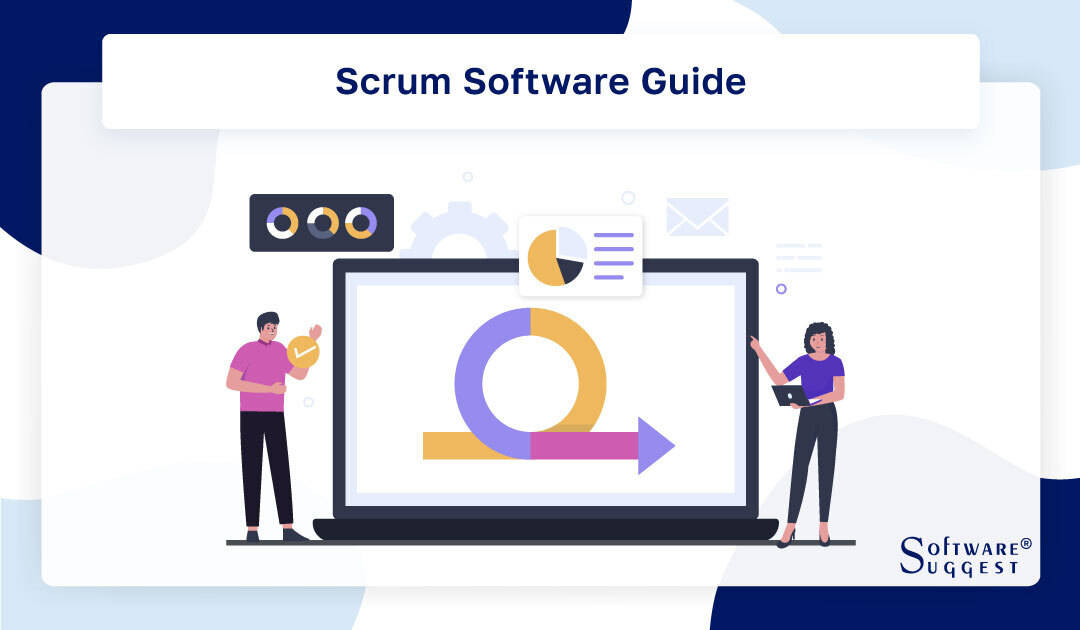
Increased advancement in the project management sector has influenced the development of powerful frameworks of Scrum software.
Therefore, adopting agile methodologies has increased significantly recently since organizations have been striving to attain profitable and successful outcomes from their projects.
Scrum software is ranked among the top agile practices because it assists businesses to improve productivity by being able to sustain their operations with the changing market demands.
This post will give you a clear understanding of Scrum software by defining its functionality and describing why it is an essential data analysis tool.
What is Scrum?
Scrum is a popular project management tool for complex software projects that emphasizes teamwork, flexibility, and customer satisfaction.
Based on Scrum's specialties in the project management field, the software organizes workflow using roles, events, and artifacts. Cross-functional teams use the framework to organize two- to four-week sprints. Continuous feedback and improvement allow Scrum teams to quickly adapt to changing requirements and add value to stakeholders.
Scrum project success depends on the Product Owner, Scrum Master, and the Development Team.
Scrum is popular in dynamic project management settings beyond software development because of its transparency, inspection, and flexibility.
What is a Scrum Software?
Scrum Software is a project management tool whose framework organizations implement to enhance their project management procedures.
Further, being an agile framework, Scrum software enhances advanced development in the software industry, enabling certified Scrum product owners to come up with very reliable and high-quality products.
Sprint planning, backlog prioritization, and daily stand-up meetings help Scrum teams organize and manage their work.
These technologies speed their development via backlog management, real-time progress tracking, reporting, and analytics. The best Scrum software has easy-to-use interfaces, smooth connections, and mobile accessibility.
Openness, accountability, and task management enhance productivity and customer satisfaction.
Scrum software lets teams utilize Scrum methods for improved project delivery and collaboration.
What is the Difference Between Scrum and Agile?
The popular software development framework Agile emphasizes adaptability. Further, Agile software development values customer feedback, adaptation, and collaboration. Flexible planning, development, and regular dissemination of tiny, fully functioning increments are key to this technique. Agile development combines client feedback and adjusts swiftly to changing needs. This method makes project management adaptable. Agile's methodology also lets development teams make necessary modifications to meet client requirements.
Scrum is a software development project management method. Moreover, Scrum is a framework for managing complicated software projects. Scrum principles are used to improve project management using new processes and roles since the techniques involve the use of two- to four-week sprints to develop. Daily stand-up meetings to discuss progress and conflicts are crucial to Scrum. This strategy also puts a lot on the Scrum Master and Product Owner. The revered Product Owner safeguards the customer's interests and carefully prioritizes and guides heroic development operations, while the Scrum Master defends Scrum's values.
Agile provides a wide project management framework. On the other hand, Scrum is more customized to software development's unique needs and complexities.
Organizations implementing Agile or Scrum must understand their subtle differences. Agile gives direction and purpose, whereas Scrum provides practical methods and duties to manage Agile projects. Software development becomes more responsive and client-focused with both methods.
What are the Use Cases of Scrum Software?
Scrum software changes task structure and execution in project management and collaboration. Scrum software improves project agility, adaptability, and efficiency across sectors.
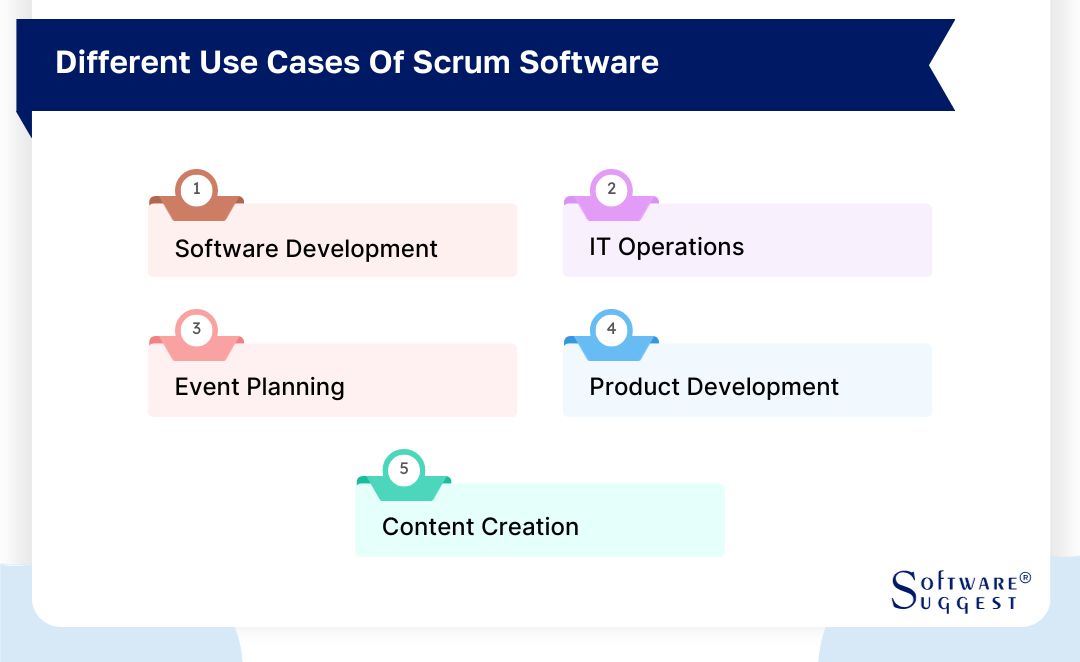
-
Software Development
Scrum's main use is software development. The hierarchical architecture allows gradual expansion, assuring project adaptability. Scrum's focus on feedback, cooperation, and change matches software development's fluidity.
-
IT Operations
IT operations improve workflows, collaboration, and processes via Scrum. By sprinting difficult work, Scrum is a project management tool that helps IT teams adopt technology, update systems, and address technical problems.
-
Event Planning
Scrum aids software and event planning. The system lets event organizers cover all aspects with iterative planning and execution. Scrum aids event logistics and marketing teams.
-
Product Development
Scrum software is a project management tool that facilitates collaborative product development. It helps cross-functional teams enhance products iteratively. Quality goods are improved via user feedback.
-
Content Creation
Content and technology development use Scrum. Scrum's iterative cycles aid content teams' editing, development, and release schedules. Fast, high-quality content development is possible.
Scrum is an adaptable project management tool for many businesses. Efficiency and quality require teamwork, adaptation, and project management. Scrum software helps teams succeed and interact as agile methodologies grow.
Why is Scrum Important in Software Development?
Software development is dynamic; thus, efficiency matters. The innovative Scrum framework boosts project success. Five reasons Scrum is essential for software development.
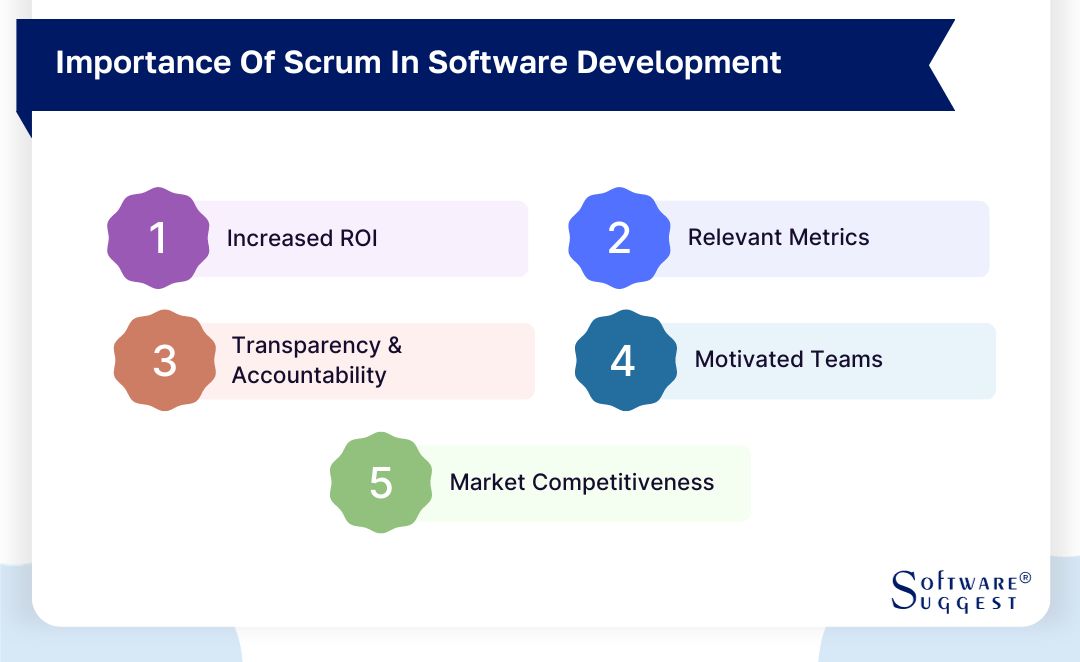
-
Increased Return On Investment (ROI)
Scrum's primary value is ROI. Scrum fosters product reviews to stay market-relevant. Traditional development yields outmoded products at launch. Scrum's incremental value accelerates product launch and revenue.
Scrum's process found and fixed defects early, lowering expenses. This proactive strategy boosts product lifecycle ROI. Besides, Scrum processes yield results, helping stakeholders adapt to market changes.
-
Relevant Metrics
Programming project estimation is always difficult. Scrum project management software helps teams decide with relevant analytics. Velocity, burndown charts, and cycle time help teams enhance operations.
Velocity estimates delivery times by measuring work each iteration. Burndown charts let stakeholders track project progress. Metrics improve project estimation and development team performance.
-
Transparency And Accountability
Transparency and accountability help Scrum project management software succeed through its framework's open and collaborative environment that lets team members track project progress. Sprint reviews, retrospectives, and daily stand-ups report project status, issues, and goals.
Transparency improves communication and accountability. Scrum's structure allows frequent inspection and modification, finding and fixing errors quickly. Transparency and accountability improve software development reliability.
-
Motivated Teams
Scrum project management software empowers and inspires developers. Scrum team ownership comes from autonomy and cross-functional collaboration. Achievement from cycles and value delivery boosts team morale.
Sprint planning, sprint reviews, and daily stand-ups improve communication and goal alignment. Development stimulates teams with regular results. Teams can evaluate their performance and improve efficiency and satisfaction with Scrum.
-
Market Competitiveness
Today's competitive corporate environment necessitates a fast market response. Adapting to new requirements and Scrum's development make companies more competitive.
Early MVP releases provide organizations with a competitive edge by launching faster. Scrum's continuous feedback loop lets it quickly adjust to market changes and user feedback to satisfy customer expectations.
Finally, Scrum's software development value goes beyond its approach. Changes mindset to promote teamwork, accountability, and adaption. ROI, meaningful KPIs, transparency, engaged teams, and market competitiveness help Scrum flourish in modern software development.
What are the Benefits of Scrum Software Tools?
Scrum project management software is efficient since the system promotes teamwork and responsiveness using Scrum. Smart utilization of cutting-edge tools is essential for Scrum deployment. These tools are crucial for project management and operations optimization.
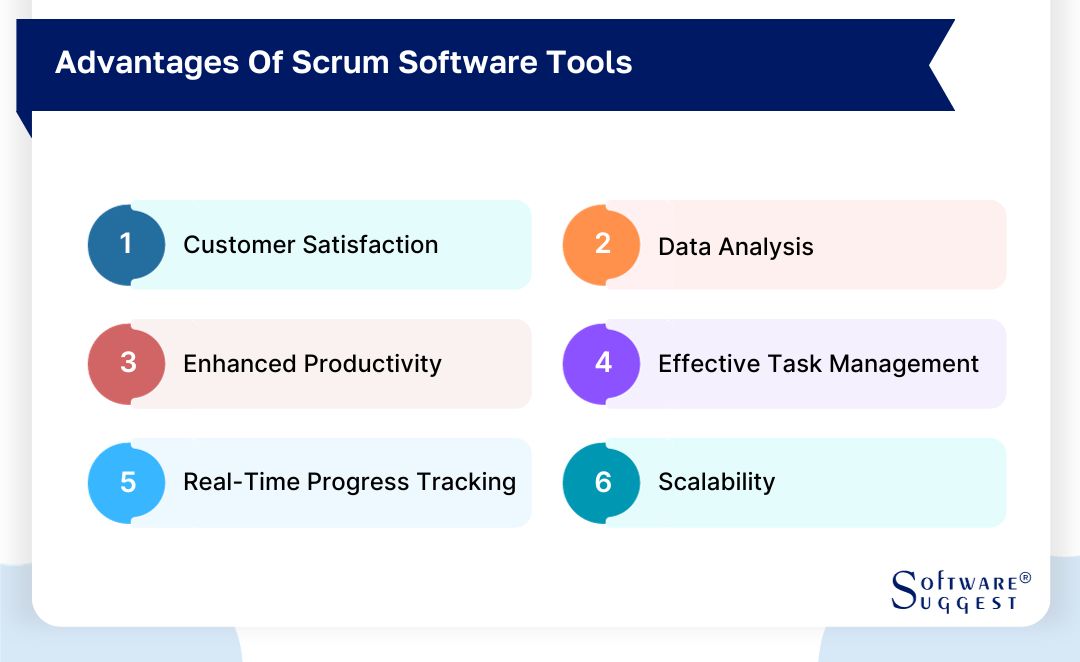
-
Customer satisfaction
Modern industrial projects depend on customer satisfaction. Scrum software boosts customer satisfaction by promoting transparency and collaboration. Interactive dashboards and real-time communication channels involve stakeholders in development. Inclusion fulfills customer expectations and provides them with project control.
-
Data Analysis
Scrum software agile team solutions provide project data for decision-making. They offer advanced analysis of activities, scheduling, and resource allocation. The tools enable project managers to develop relevant reports, discover trends, and make wise decisions. Project data insights promote strategic planning and ongoing improvement by learning from past experiences.
-
Enhanced Productivity
Scrum agile teams emphasize sprints and development cycles. Scrum software simplifies sprint planning, execution, and monitoring, promoting project delivery. Productivity rises as teams provide high-value product increments fast. Collaboration, resource optimization, and bottleneck reduction boost project productivity with these tools.
-
Effective Task Management
Scrum master prioritizes breaking project requirements into manageable tasks. Scrum software tools prioritize work allocation, tracking, and completion for efficient task management. Team members prioritize and organize using user stories, task boards, and backlog management tools. This ensures team support for project goals and streamlines workflow.
-
Real-Time Progress Tracking
Scrum software allows real-time progress tracking. Traditional project management may not provide timely progress updates. Scrum technologies let stakeholders track progress with dynamic visualizations, burndown charts, and sprint reports. Instant visibility helps manage projects and prevent issues from escalating.
-
Scalability
Scrum software supports projects of varied sizes and complexity. These tools scale Scrum for small and large companies. These modular technologies allow teams to customize procedures and suit the Scrum framework to any project size.
Scrum software solutions transform project management, enhancing collaboration, efficiency, and customer satisfaction. These solutions help companies navigate modern project landscapes and create value and customer-centeredness.
What are the Features of Scrum Software Solutions?
Scrum tools are flexible project management strategies that encourage teamwork. Companies employ technology to streamline and optimize project management to realize Scrum's potential. In this piece, we explain why Scrum teams need these tools.
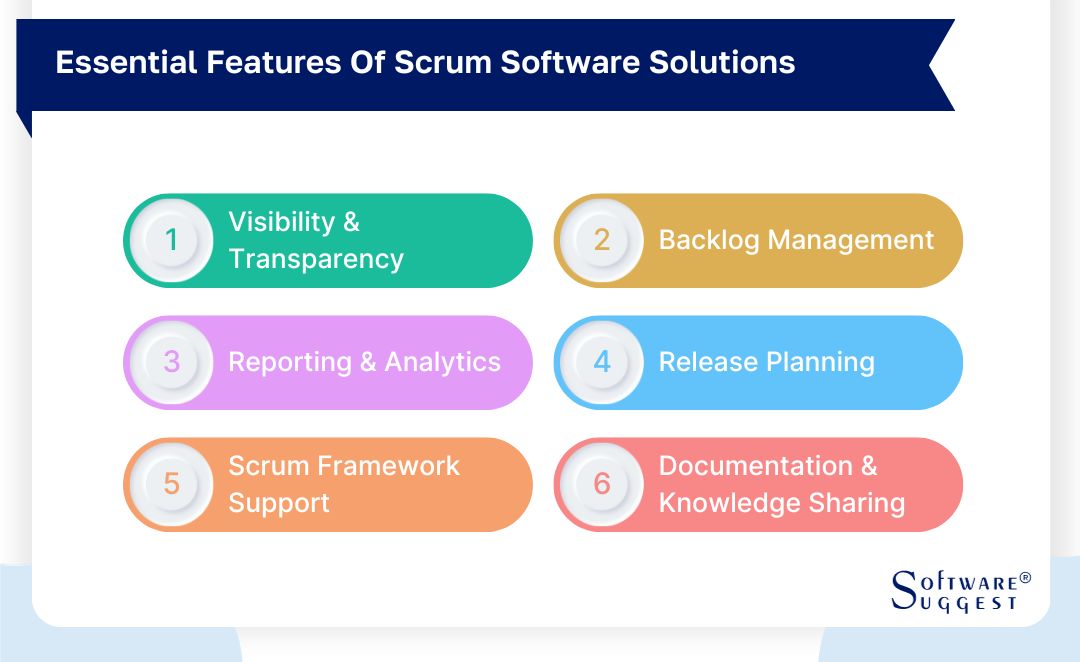
-
Visibility & Transparency
Scrum tools emphasize transparency and visibility. Scrum provides unrivaled project visibility. These tools show real-time sprint progress, burndown charts, and team velocity. By updating team members on project progress, transparency encourages openness and accountability. Teams can swiftly identify and resolve issues with a clear procedure, enhancing project delivery.
-
Backlog Management
Scrum tool implementation requires good management since product backlogs are created, prioritized, and modified using Scrum. These systems' easy-to-use interfaces help product owners and teams manage the backlog. Advanced filtering and sorting help teams prioritize high-priority issues to meet project goals. Automated tracking and changes simplify and collaborate backlog management.
-
Reporting and Analytics
Scrum software solutions emphasize reporting and analytics in a data-driven society. The tools provide several customized reports on team performance, sprint progress, and project health. Sprint burndown charts and cumulative flow diagrams help teams identify trends, optimize processes, and make data-driven decisions. Detailed reports help teams examine data and optimize operations for efficiency.
-
Release Planning
Scrum tools are crucial to delivering incremental value to stakeholders. Scrum release backlogs, capacity planning, and dependency tracking assist plan releases. These tools assist teams in aligning development with business goals and creating realistic release plans. Seeing dependencies and anticipating bottlenecks can help teams reduce risks and maintain a predictable release window.
-
Scrum Framework Support
Scrum's benefits depend on following its framework. Scrum-compatible software works effortlessly. Pre-configured Scrum boards, sprint planning tools, and sprint reviews match Scrum events and artifacts. Encapsulating Scrum best practices in software lets teams focus on value delivery rather than framework complexities, making Scrum deployment smoother and more consistent.
-
Documentation and Knowledge Sharing
Scrum teams need consistent documentation and knowledge exchange. Scrum tools allow collaborative document generation and storage, making vital information accessible. Integration with knowledge-sharing platforms increases teamwork and ideation. These tools centralize documentation and information sharing, encouraging organizational learning and improvement.
Maximizing Scrum's benefits requires software solutions. These technologies improve visibility, backlog management, reporting, release planning, Scrum framework alignment, documentation, and knowledge sharing to help teams adopt Scrum and deliver value agilely.
How Do You Select the Right Scrum Software?
An agile project management company must choose the right Scrum software. Software choice strongly impacts Scrum tools implementation success. User Interface (UI), Integration, Value for Money, Mobile Accessibility, Usability, and Customizability are six major Scrum software evaluation and selection aspects.

-
User Interface (UI)
Scrum software must have an easy-to-use UI. Well-designed UIs boost software interaction. It should simplify navigation, project progress, and teamwork. A confusing UI slows productivity and hinders Scrum adoption. Choose software with a nice interface for smooth working.
-
Integration
Scrum tools should work well with other organizational tools and systems. Integration improves program functionality by transmitting data between platforms. This eliminates data silos and unifies project management by assuring data flow across tools. Version control, communication, and testing should work with Scrum. Integration eliminates manual labour, errors, and process inefficiency.
-
Value for Money
While money is crucial, prioritize Scrum software's complete value. Pricing vs. features, functions, and support. Advanced features that match organizational needs may justify a higher software price. Think long-term and ROI, not simply the first investment. Review the software's pricing plans to ensure they can accommodate company expansion.
-
Mobile Accessibility
Mobile Scrum software is essential in today's dynamic workplace. Mobile connectivity helps team members communicate remotely. Choose software with a mobile-friendly UI or mobile apps for work management, project tracking, and team collaboration on smartphones and tablets. Team reaction and project management agility improve with flexibility.
-
Usability
Usability goes beyond the UI to help team members navigate and complete tasks. Scrum is easy to understand so that team members can adapt. Consider simple project, task, and report creation. User adoption, training time, and Scrum implementation improve with usability.
Customizability: Scrum project management tools should adapt to each company's processes and needs. The application can be tailored to business procedures and workflows. Select software with configurable fields, workflows, and reporting. Scrum software can be customized to the company's project management procedures, making integration easier.
Challenges Faced in Scrum Software
Software developers seeking agility and efficiency like Scrum. Scrum teams face challenges that can slow growth and limit capabilities. Scrum software development challenges include teamwork, estimation accuracy, technical debt, and sustainability.

-
Team Collaboration
Scrum tools demand teamwork. Scrum projects need teamwork and communication. Harmonious cooperation is harder. Teams struggle with goals, coordination, and communication.
Diversity in abilities, viewpoints, and communication styles challenges many teams. Building a good team requires bridging these gaps and supporting inclusivity. Team leaders must foster creativity and consensus.
Geographical remoteness may hinder teamwork. Remote workers' time zones may hinder synchronized collaboration. Virtual cooperation and effective communication are needed to overcome these hurdles and preserve teamwork.
-
Estimation Accuracy
Scrum project planning demands accurate estimation. Software development is unpredictable, making team estimates challenging. Forecasts can affect project timeframes, resource allocation, and stakeholder expectations.
Software development is unpredictable, making prediction difficult. Unexpected issues, changes, and technical issues can derail even the best projections. Teams must acknowledge uncertainty and change estimations based on real-time feedback and development insights.
Agile teams estimate better using story points and planning poker. Teams estimate better with retrospective and past initiative continuous improvement attitudes.
-
Technical Debt
Teams often incur technological debt to produce rapidly, balancing short-term gains and long-term maintainability. Technical debt is inevitable, but managing it properly prevents delays.
Technical debt includes refactored code, delayed patches, and deadline shortcuts. Codebase health and speed management are constant challenges. Technical debt lowers code quality, making feature addition and bug fixing difficult.
Technical debt must be managed proactively. Each sprint must include codebase assessment, reworking, and debt reduction. Technical debt reduction helps teams progress smoothly and maintain code health.
-
Sustainability
Scrum's focus on features might harm sustainability. Stakeholder demands can lead to fatigue and neglect of teams.
Scrum sustainability includes team health and effectiveness. Short-term goals without team competence and well-being can produce fatigue, turnover, and bad morale.
Teams must be sustainable for workplace wellness. Increase teamwork with achievable goals, task management, and retrospectives. Sustainable Scrum teams require work-life balance, professional development, and a supportive culture.
Latest Market Trends in Scrum Software
Scrum tools transformed agile software development teams and software development. Firms become more agile and responsive by following Scrum board market advancements. We explore four Scrum software trends: AI and Automation, Remote Work Collaboration, SAFe Support, and Environmental Sustainability.

-
Artificial Intelligence (AI) and Automation
Today, AI and automation change the Scrum board. AI helps Scrum sprint planning and backlog management. Teams analyze historical project data with machine learning algorithms to make data-driven decisions and estimates. Automation lets teams focus on higher-value tasks instead of monotonous tasks. Automated testing, continuous integration, and deployment pipelines let Scrum teams deliver high-quality software quickly.
-
Remote Work Collaboration
Global remote work has impacted Scrum team relations. Teams with different locations need good remote work collaboration tools. Scrum systems improve virtual communication, task tracking, and collaboration. Scrum board now includes video conferencing, real-time collaboration, and digital Scrum boards to assist remote teams in cooperating. Virtual sprint planning, daily stand-ups, and sprint evaluations resemble in-person activities.
-
Scaled Agile Framework (SAFe) Support
Managing Large-Scale Agile Implementations with SAFe Support As organizations adopt Agile principles, demand for Scrum software supporting SAFe has grown. SAFe organizes many Agile Release Trains (ARTs) to extend Agile and Lean to larger teams and organizations. With SAFe principles like PI (Program Increment) planning, organizations can synchronize value delivery across numerous teams and address enterprise-level Agile changes systematically.
-
Environmental Sustainability
Scrum board promotes global sustainability. Priorities include optimizing software development and lowering environmental impact. Scrum teams promote green and carbon-reducing development. Scrum tool considerations include energy-efficient infrastructure, virtualization, and green code. Many Scrum software platforms let teams monitor their environmental effect for corporate social responsibility.
What is the Cost of the Scrum Software Tools?
Agile methods like the Scrum tool improve teamwork, adaptability, and efficiency in fast-paced project management. Organizations must assess software tool expenses when using Scrum.
This section compares the cost of common Scrum software solutions to demonstrate how adding them to your project management raises costs. Most scrum software tools come at a price of around $10/per user/per month.
Here is the pricing of the best scrum software tools:
- ClickUp: The adaptable freelancer and enterprise platform ClickUp leads Scrum software solutions. ClickUp is cheap for solo practitioners and small teams at $9/user/month.
- Zoho Sprints: Zoho Sprints suits real-time teams with its basic Scrum board. Up to 100 people can utilize Zoho Sprints for $3/user/month in mid-sized teams.
- Miro: Miro's video-conferencing platform surpasses Scrum. Miro beats Scrum at $10/user/month. Video conferencing helps remote teams collaborate.
- Hubstaff: Hubstaff appeals to cost-conscious customers with free Scrum software. Hubstaff is free; however, the full suite costs $7/user/month.
Conclusion
In summary, Scrum software provides flexible choices for project management teams. As companies adopt agile methods like Scrum, choosing the right tools becomes crucial. This article has explained the basics, benefits, drawbacks, and current trends related to Scrum software.
Scrum software boosts customer satisfaction, job management, productivity, and real-time progress tracking. These project management tools enhance the overall experience by promoting collaboration, transparency, and efficiency. Teams require tools to address challenges in adopting Scrum, such as teamwork, accurate estimation, managing technical debt, and ensuring sustainability.
FAQs
Scrum has three roles: Scrum Master (ensures process, removes obstacles), Product Owner (prioritizes features), and Development Team (self-organizing, delivers product increments).
Scrum operates in reliable cycles since the Product Owner prioritizes work, the team commits to delivering it, and daily stand-ups ensure alignment. The strategy concludes with a review and retrospective, fostering continuous improvement and value delivery.












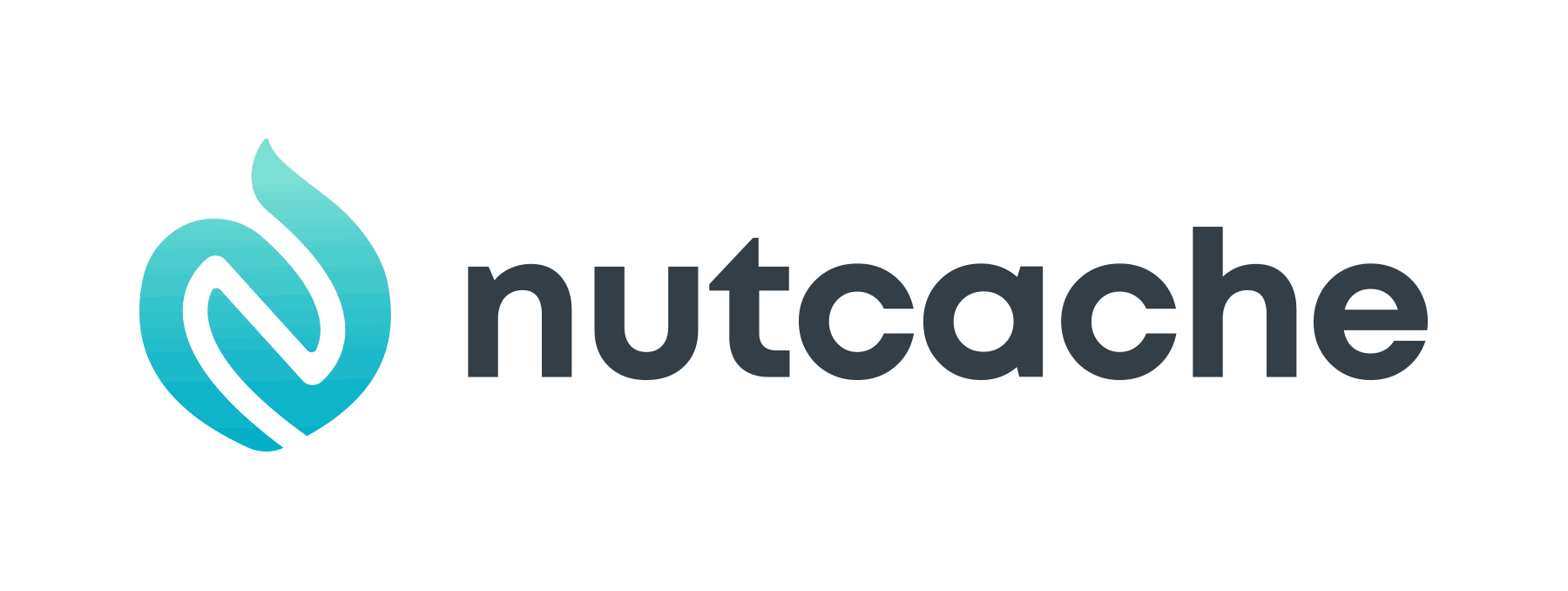

.png)

